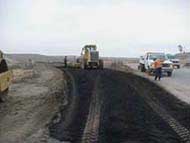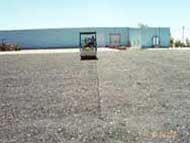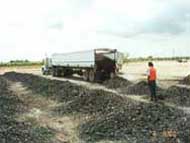| Hot-Mix Asphalt (HMA)
The use of RAS in HMA is by far the most popular recycling path with several state highway agencies researching and permitting its use in their mixes. The added asphalt decreases the demand for both virgin asphalt cement and aggregate, while improving the properties of HMA pavement. Cutbacks from shingle factories can be ground up and added to the HMA process or regenerated with rejuvenating chemicals prior to the HMA process. Though states are continuing to research and permit use, several are reducing or setting a more conservative value for the amount of RAS permitted in a mix. Research indicates that a finer grinding (e.g. material less than 3/8”) will create more efficient mixes. Rejuvenators (chemical additives used to rejuvenate properties of aged asphalt binders) are being investigated by states for use in mixes, and some are evaluating the effect of using rejuvenators with RAS. Recent research on use of RAS in combination with finer grinding sizes and rejuvenators has shown positive results on asphalt mix properties, but further research should be performed in this area. NAPA reported in 2016 that 42 states permitted use of RAS in at least some commercial and residential mixes, while 5 states do not permit use of RAS in any mixes [2].
The use of RAS in asphalt mixtures can have benefits aside from resource and greenhouse gas savings. Draindown in asphalt mixtures is when the asphalt binder material loses its binding with the aggregate during transportation or placement and drains down further into the mixture from the surface. The use of fibers in asphalt mixtures has been shown to reduce the level of draindown in mixtures and reinforce the matrix. Fiberglass or cellulose fibers contained in RAS can therefore aid in minimizing draindown in asphalt mixes [4].
The use of RAS in HMA can depend on the level of coordination between environmental and transportation agencies in the state. Illinois is one example where RAS is being responsibly used in the production of HMA. Shingle recyclers must be permitted by both the Illinois Environmental Protection Agency and the Illinois Department of Transportation (IDOT) before beginning operation and using the RAS they produce in IDOT mixes. In addition, pursuant to Section 22.54 of the Illinois Environmental Protection Act, landfills cannot accept shingle loads if they are located within a 25-mile radius of a permitted shingle recycling facility. Illinois’ success in roadways was extended to runways in 2014 when the state’s Chicago O’Hare International Airport runways became the first in the country to use RAS with the approval of the Federal Aviation Administration (FAA) [5]. This level of success points to the state’s coordination and responsible management of RAS in the HMA market.
On the national level, NAPA continues to survey asphalt pavement producers on the use RAS and summarize its use in their annual survey [2]. In addition to Illinois, other states continue to progress the use of RAS in HMA. The Vermont Agency of Transportation will be including specifications on the use of pre and post-consumer RAS in their mixes in their 2019 specifications [6]. The Wisconsin Department of Natural Resources currently requires recyclers to be approved before sending RAS to an asphalt plant and will be publishing guides for recyclers in the near future [7]. In New York, the State Department of Transportation moved out of trial use and issued specifications allowing RAS in their mixes in 2015 [8]. Finally, in terms of future use, the Delaware Department of Transportation is conducting a study in 2018 to analyze the properties of RAS mixes with and without the use of rejuvenators to find if their use may be beneficial to RAS mixes [9].
Warm Mix Asphalt
Some studies have looked at the use of RAS in combination with Warm Mix Asphalt (WMA) technology. Similar to results seen with HMA, RAS is seen as a viable addition to WMA mixes and it helps to improve the rutting resistance of the pavement [10]. A study from Rutgers in 2017 looked directly at how use of WMA would aid with compaction of stiff asphalt mixes that contain RAS. The study concluded that WMA does appear to aid in the ability to compact the mix. Also, a “5 to 20 degrees Fahrenheit reduction in mixing and compaction temperatures can be achieved” for RAS mixes when using WMA [11].
Porous Asphalt Pavement
A study conducted in 2011 by researchers for the U.S. Green Building Council was one of the first to look at the use of RAS in porous asphalt pavement. The addition of RAS was believed to add stiffness to the otherwise soft porous asphalt pavement mixture. This property of RAS binder could offset the cost of using a more expensive and stiffer asphalt binder. The study found that mixtures containing RAS had better rutting performance than mixtures containing a higher grade asphalt binder. Brittleness of the RAS mixture at cold temperatures was not evaluated in the study [12].
|



